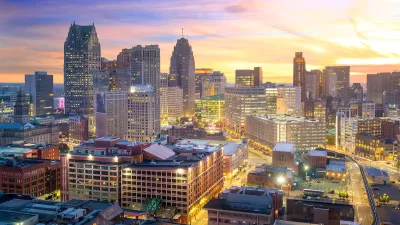Mega-cities of 10 million people or more are getting a lot of attention these days. But smaller big cities are really where interesting and potentially hazardous growth patterns are occurring, according to this piece.
Neal Peirce reviews new research from the Lincoln Institute of Land Policy that looks at growth patterns over time in cities across the globe -- particularly cities with populations smaller than 10 million.
"[C]umulatively, the unfolding land consumption will be the most extreme in cities above 100,000 and below the 10 million mark. There are 3,646 of these in the world. And many tell amazing growth tales.
Take Accra, capital of Ghana. Between 1985 and 2000 (latest available count), its population grew 50 percent - from 1.8 to 2.7 million. But its urban land cover spiraled 135 percent.
Using a Landsat-based sampling of physical expansion of 120 word cities between 1990 and 2000, Shlomo (Solly) Angel and his associates at the Lincoln Institute of Land Policy found they were all growing physically at least twice as fast as their populations were actually increasing."
FULL STORY: World Cities: Where to Put Their Oncoming Billions?

Manufactured Crisis: Losing the Nation’s Largest Source of Unsubsidized Affordable Housing
Manufactured housing communities have long been an affordable housing option for millions of people living in the U.S., but that affordability is disappearing rapidly. How did we get here?

Americans May Be Stuck — But Why?
Americans are moving a lot less than they once did, and that is a problem. While Yoni Applebaum, in his highly-publicized article Stuck, gets the reasons badly wrong, it's still important to ask: why are we moving so much less than before?

Using Old Oil and Gas Wells for Green Energy Storage
Penn State researchers have found that repurposing abandoned oil and gas wells for geothermal-assisted compressed-air energy storage can boost efficiency, reduce environmental risks, and support clean energy and job transitions.

Updating LA’s Tree Rules Could Bring More Shade to Underserved Neighborhoods
A new USC study finds that relaxing Los Angeles’ outdated tree planting guidelines could significantly expand urban tree canopy and reduce shade disparities in lower-income neighborhoods, though infrastructure investments are also needed.

California's Canal Solar Projects Aim to Conserve Resources and Expand Clean Energy
California’s Project Nexus has begun generating electricity from solar panels installed over irrigation canals, with researchers and state agencies exploring statewide expansion to conserve water and boost clean energy production.

HHS Staff Cuts Gut Energy Assistance Program
The full staff of a federal program that distributes heating and cooling assistance for low-income families was laid off, jeopardizing the program’s operations.
Urban Design for Planners 1: Software Tools
This six-course series explores essential urban design concepts using open source software and equips planners with the tools they need to participate fully in the urban design process.
Planning for Universal Design
Learn the tools for implementing Universal Design in planning regulations.
Heyer Gruel & Associates PA
City of Moreno Valley
Institute for Housing and Urban Development Studies (IHS)
City of Grandview
Harvard GSD Executive Education
Salt Lake City
NYU Wagner Graduate School of Public Service
City of Cambridge, Maryland




























